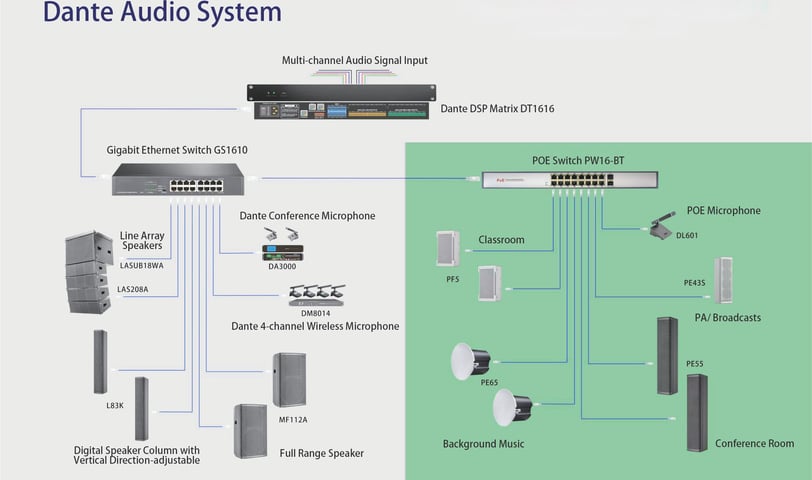Dante Sound System: Revolutionizing Audio Industry
Discover how the Dante sound system, developed by Audinate, transforms the audio industry through standard IP networks. Experience high-quality, uncompressed audio with ultra-low latency, ensuring flexibility, scalability, and reliability for modern audio infrastructures across various industries.
1/16/20243 min read


1. Live Events and Performances
In the high-pressure environment of live concerts, theater productions, and festivals, Dante’s real-time audio networking shines.
Seamless Multi-Channel Routing: Dante enables engineers to route hundreds of audio channels over a single Ethernet cable, replacing bulky analog setups. This simplifies stage setups and reduces cable clutter.
Remote Control and Monitoring: Engineers can adjust mixes, monitor levels, and troubleshoot issues from anywhere on the network using Dante-enabled software (e.g., Dante Controller).
Interoperability: Dante integrates with leading audio consoles (Yamaha, Allen & Heath) and microphones, ensuring compatibility in complex setups.
Example: Major festivals like Coachella and international tours by artists like U2 rely on Dante for flawless audio delivery.
2. Corporate and Education Environments
Dante streamlines communication in conference rooms, lecture halls, and hybrid workplaces.
Unified AV Systems: Dante synchronizes microphones, speakers, video conferencing tools, and recording devices over a single network.
Scalability: From small huddle rooms to large auditoriums, Dante systems expand effortlessly by adding endpoints to the network.
Hybrid Work Support: Dante’s low latency ensures crisp audio for virtual participants in hybrid meetings, enhancing collaboration.
Example: Microsoft’s Teams Rooms and university lecture halls use Dante to deliver professional-grade audio experiences.
3. Broadcast and Studio Production
Dante’s precision and reliability are critical for broadcast studios and recording facilities.
Multi-Studio Integration: Audio from multiple studios, control rooms, and live feeds can be shared across a facility without signal degradation.
Synchronization with Video: Dante’s AES67 compliance ensures perfect lip-sync alignment with video streams, essential for live TV and film production.
Cloud Integration: Emerging solutions like Dante AVIO adapters enable cloud-based audio processing and remote collaboration.
Example: The BBC and NBC Olympics have adopted Dante for large-scale broadcast workflows.
4. Hospitality and Public Venues
From airports to museums, Dante enhances visitor experiences through immersive soundscapes.
Distributed Audio Zones: Dante allows tailored audio delivery to different areas (e.g., background music in hotel lobbies, announcements in transit hubs).
Centralized Management: Facility managers can control all audio endpoints via a single interface, reducing maintenance complexity.
Emergency Systems Integration: Dante supports real-time emergency alerts routed through the same network as entertainment audio.
Example: The Louvre Museum uses Dante to synchronize multilingual guided tours across exhibits.
5. Architectural Acoustics and Smart Buildings
Dante is integral to modern smart building designs, blending audio with IoT (Internet of Things) ecosystems.
Voice-Controlled Environments: Dante-compatible systems integrate with smart assistants (e.g., Alexa for Business) for voice-activated room controls.
Energy Efficiency: Centralized audio networks reduce the need for redundant hardware, lowering power consumption.
Adaptive Soundscapes: Dante enables dynamic audio adjustments based on occupancy sensors or time of day (e.g., calming music in office lounges).
6. Transportation Hubs
Airports, train stations, and stadiums rely on Dante for clear, reliable public address (PA) systems.
Redundancy and Failover: Dante’s redundant networking ensures uninterrupted announcements even during network disruptions.
Multi-Language Support: Audio feeds in multiple languages can be distributed simultaneously to different zones.
Example: Singapore Changi Airport uses Dante to manage announcements across its vast terminals.
7. Immersive Entertainment and Gaming
Dante drives next-generation audio experiences in theme parks, VR arcades, and gaming arenas.
3D Spatial Audio: Dante synchronizes object-based audio (e.g., Dolby Atmos) across multi-speaker arrays for immersive environments.
Low-Latency Gaming: Esports venues use Dante to eliminate audio lag, critical for competitive gameplay.
Technical Advantages of Dante
Low Latency: Sub-millisecond delays ensure real-time audio synchronization.
High Fidelity: Supports up to 24-bit/192kHz audio for studio-grade quality.
Scalability: Thousands of channels can coexist on a single network.
Cost Efficiency: Reduces cabling and hardware costs through IP convergence.
The Future of Dante
As audio-over-IP becomes ubiquitous, Dante continues to innovate with solutions like Dante Domain Manager for secure large-scale networks and Dante AV for integrating video. With the rise of 5G and edge computing, Dante is poised to support decentralized, cloud-native audio ecosystems.
Conclusion
The Dante sound system is not just a tool but a foundational technology shaping the future of audio networking. Its applications span industries, empowering professionals to deliver exceptional auditory experiences while simplifying infrastructure. As connectivity demands grow, Dante’s role as the backbone of modern audio systems will only expand, cementing its status as an indispensable asset in the digital age.
Keywords: Dante audio networking, IP audio, live sound, AV integration, smart buildings, broadcast audio.
